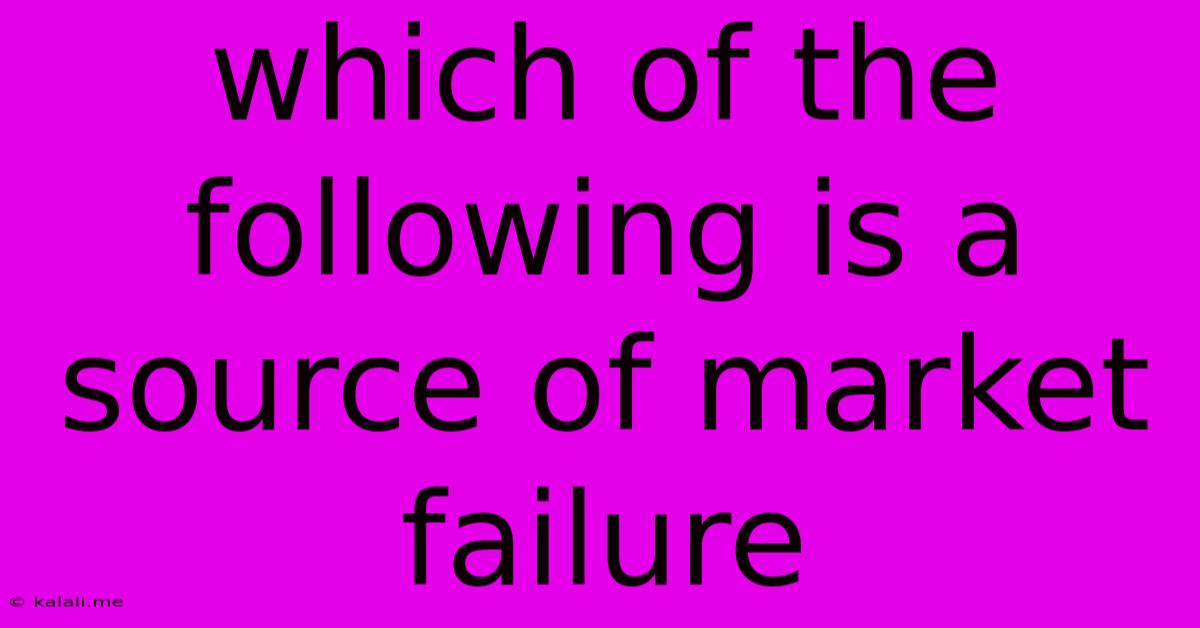Which Of The Following Is A Source Of Market Failure
Kalali
Jun 13, 2025 · 3 min read

Table of Contents
Which of the Following is a Source of Market Failure? Understanding Imperfect Markets
Market failure occurs when the free market fails to allocate resources efficiently, leading to a suboptimal outcome for society. This article explores several key sources of market failure, providing clear examples and explaining why they disrupt the ideal functioning of a competitive market. Understanding these sources is crucial for policymakers and businesses alike.
What is Market Failure? Simply put, market failure happens when the market mechanism—the interaction of supply and demand—doesn't produce the most efficient or socially desirable outcome. This inefficiency can manifest in several ways, including underproduction, overproduction, or the production of the wrong goods and services. Understanding the causes allows for the development of potential solutions, whether through government intervention or other mechanisms.
Key Sources of Market Failure:
Several factors can contribute to market failure. Here are some of the most common:
1. Externalities: The Unseen Costs and Benefits
Externalities represent a significant source of market failure. These are costs or benefits that affect a party who did not choose to incur that cost or benefit. They are "external" to the market transaction.
-
Negative Externalities: These impose costs on third parties. Classic examples include pollution from a factory affecting nearby residents' health or noise pollution from a concert impacting nearby homes. In these cases, the market price doesn't reflect the true social cost of production, leading to overproduction.
-
Positive Externalities: These provide benefits to third parties. Education is a prime example; an educated populace benefits society as a whole through increased productivity and innovation, even though the individual benefits are primarily reaped by the educated person. The market underprovides goods with positive externalities because their social benefit exceeds their private benefit.
2. Public Goods: The Free-Rider Problem
Public goods are non-excludable (difficult or impossible to prevent people from consuming them) and non-rivalrous (one person's consumption doesn't diminish another's). Examples include national defense and clean air. Because of their nature, the free market often underprovides public goods due to the "free-rider problem." Individuals can benefit from a public good without paying for it, leading to insufficient provision by private entities.
3. Information Asymmetry: The Knowledge Gap
Information asymmetry arises when one party in a transaction has more or better information than the other. This imbalance can lead to inefficient outcomes. For example, a used car seller might know more about a car's defects than a buyer, leading to potentially unfair prices. Similarly, insurance companies might struggle to accurately assess risk due to incomplete information about policyholders.
4. Market Power: Monopolies and Oligopolies
When a single firm or a small group of firms dominates a market (monopoly or oligopoly), they can restrict output and raise prices above competitive levels, leading to reduced consumer surplus and deadweight loss. This restriction of output and inflated pricing represents a significant deviation from efficient market outcomes. The lack of competition prevents the market from functioning optimally.
5. Transaction Costs: The Friction of Exchange
Transaction costs are the costs associated with making a transaction, including searching for information, negotiating contracts, and enforcing agreements. High transaction costs can prevent mutually beneficial trades from occurring, leading to inefficient resource allocation. For instance, high search costs for finding the best price might lead consumers to purchase less efficiently.
Conclusion:
These are just some of the key sources of market failure. Recognizing these imperfections is crucial for developing policies that aim to improve market efficiency and promote social welfare. Understanding the underlying causes of market failure allows for the design of interventions aimed at correcting these issues and maximizing societal benefit. From addressing externalities through regulations to providing public goods through government funding, various approaches exist to mitigate the negative consequences of market failure.
Latest Posts
Latest Posts
-
Who Is The Father Of Computer Security
Jun 14, 2025
-
What Is Not Part Of The Axial Skeleton
Jun 14, 2025
-
What Is The Measure Of Abc 88
Jun 14, 2025
-
Which Network Device Connects Multiple Networks Together
Jun 14, 2025
-
Which Of The Following Is The Best
Jun 14, 2025
Related Post
Thank you for visiting our website which covers about Which Of The Following Is A Source Of Market Failure . We hope the information provided has been useful to you. Feel free to contact us if you have any questions or need further assistance. See you next time and don't miss to bookmark.